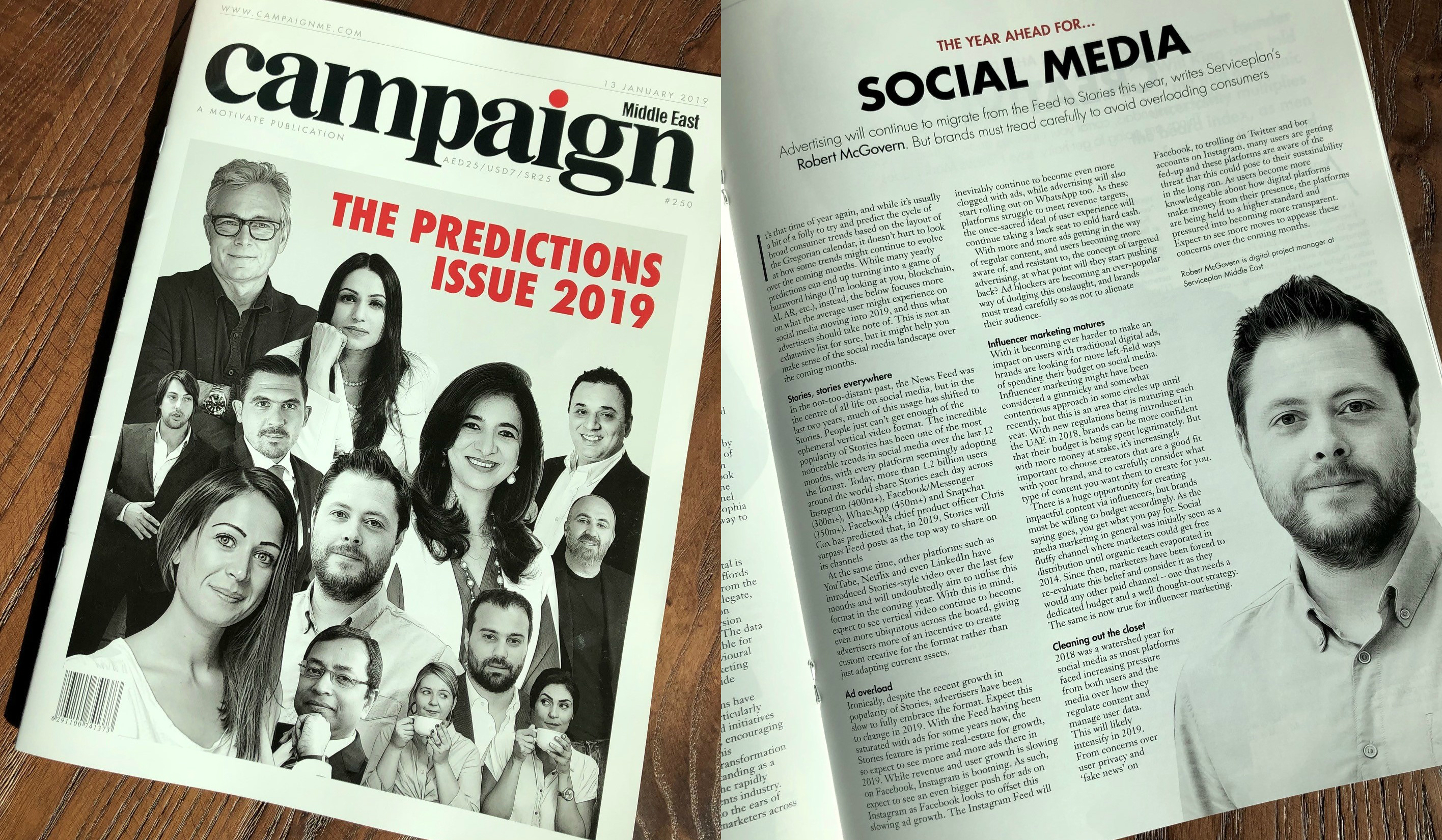This article was originally featured in the Predictions 2019 issue of Campaign Middle East magazine on 13th Jan 2019.
It’s that time of year again, and while it’s usually a bit of a folly to try and predict the cycle of broad consumer trends based on the layout of the Gregorian calendar, it doesn’t hurt to look at how some trends might continue to evolve over the coming months. While many yearly predictions can end up turning into a game of buzzword bingo (I’m looking at you Blockchain, AI, AR etc.), instead, the below focuses more on what the average user might experience on social media moving into 2019, and thus what advertisers should take note of. This is not an exhaustive list for sure, but it might help you make sense of the social media landscape over the coming months.
STORIES, STORIES EVERYWHERE
In the not-too-distant past, the News Feed was the centre of all life on social media, but in the last two years, much of this usage has shifted to Stories. People just can’t get enough of the ephemeral vertical video format. The incredible popularity of Stories has been one of the most noticeable trends in social media over the last 12 months, with every platform seemingly adopting the format. Today, more than 1.2 billion users around the world share Stories each day across Instagram (400m+), Facebook / Messenger (300m+), WhatsApp (450m+) and Snapchat (150m+). Facebook’s chief product officer Chris Cox has predicted that, in 2019, Stories will surpass feed posts as the top way to share on its channels.
At the same time, other platforms like YouTube, Netflix and even LinkedIn have introduced Stories-style video over the last few months and will undoubtedly aim to utilize this format in the coming year. With this in mind, expect to see vertical video continue to become even more ubiquitous across the board, giving advertisers more of an incentive to create custom creative for the format rather than just adapting current assets.
AD OVERLOAD
Ironically, despite the recent growth in popularity of Stories, advertisers have been slow to fully embrace the format. Expect this to change in 2019. With the feed having been saturated with ads for some years now, the Stories feature is prime real-estate for growth, so expect to see more and more ads there in 2019. While revenue and user growth is slowing on Facebook, Instagram is booming. As such, expect to see an even bigger push for ads on Instagram as Facebook looks to offset this slowing ad growth. The Instagram feed will inevitably continue to become even more clogged with ads, while advertising will also start rolling out on WhatsApp too. As these platforms struggle to meet revenue targets, the once-sacred ideal of user experience will continue taking a back seat to cold hard cash.
With more and more ads getting in the way of regular content, and users becoming more aware of, and resistant to, the concept of targeted advertising, at what point will they start pushing back? Ad blockers are becoming an ever-popular way of dodging this onslaught, and brands must tread carefully so as not to alienate their audience.
INFLUENCER MARKETING MATURES
With it becoming ever harder to make an impact on users with traditional digital ads, brands are looking for more left-field ways of spending their budget on social media. Influencer marketing might have been considered a gimmicky and somewhat contentious approach in some circles up until recently, but this is an area that is maturing each year. With new regulation being introduced in the UAE in 2018, brands can be more confident that their budget is being spent legitimately. But with more money at stake, it’s increasingly important to choose creators that are a good fit with your brand, and to carefully consider what type of content you want them to create for you.
There is a huge opportunity for creating impactful content via influencers, but brands must be willing to budget accordingly. As the old saying goes, you get what you pay for. Social media marketing in general was initially seen as a fluffy channel where marketers could get free distribution until organic reach evaporated in 2014. Since then, marketers have been forced to re-evaluate this belief and consider it as they would any other paid channel; one that requires a dedicated budget and a well thought-out strategy. The same is now true for influencer marketing.
CLEANING OUT THE CLOSET
2018 was a watershed year for social media as most platforms faced increasing pressure from both users and the media over how they regulate content and manage user data. This will likely intensify in 2019. From concerns over user privacy and ‘fake news’ on Facebook, to trolling on Twitter and bot accounts on Instagram, many users are getting fed-up and these platforms are aware of the threat that this could pose to their sustainability in the long run. As users become more knowledgeable about how digital platforms make money from their presence, the platforms are being held to a higher standard and pressured into becoming more transparent. Expect to see more moves to appease these concerns over the coming months.


